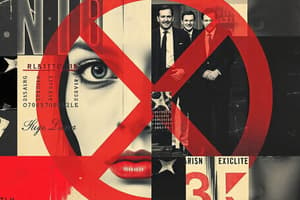Podcast
Questions and Answers
What did the Miller test set specific guidelines for?
What did the Miller test set specific guidelines for?
- Determining the constitutionality of the Communications Decency Act
- Determining what could be considered legally obscene (correct)
- Determining the relationship between viewing sexually explicit material and aggressive behavior
- Determining the relevance of international community standards
In what year did the Supreme Court unanimously outlaw child pornography?
In what year did the Supreme Court unanimously outlaw child pornography?
- 1986
- 1997
- 1996
- 1982 (correct)
What did the Ferber decision focus on preventing?
What did the Ferber decision focus on preventing?
- Aggressive behavior toward women
- Viewing sexually explicit material
- Sexual exploitation of children (correct)
- Discrimination against women
What did Congress make illegal in 1996?
What did Congress make illegal in 1996?
What did the Communications Decency Act of 1996 criminalize?
What did the Communications Decency Act of 1996 criminalize?
Why was the Communications Decency Act of 1996 held unconstitutional by the Supreme Court in 1997?
Why was the Communications Decency Act of 1996 held unconstitutional by the Supreme Court in 1997?
What does the Child Exploitation and Obscenity Section (CEOS) work with the FBI and U.S. Attorney's Offices to investigate and prosecute?
What does the Child Exploitation and Obscenity Section (CEOS) work with the FBI and U.S. Attorney's Offices to investigate and prosecute?
Which test introduced a three-part assessment to determine obscenity?
Which test introduced a three-part assessment to determine obscenity?
What was the focus of the Hicklin test followed by American courts from 1879 to the early 1930s?
What was the focus of the Hicklin test followed by American courts from 1879 to the early 1930s?
In which case did the Supreme Court establish contemporary community standards as the measure for obscenity, rejecting the Hicklin test?
In which case did the Supreme Court establish contemporary community standards as the measure for obscenity, rejecting the Hicklin test?
Which case affirmed the right to possess legally obscene material in one's home?
Which case affirmed the right to possess legally obscene material in one's home?
What did the case of Jacobellis v. Ohio in 1964 assert about the test for obscenity?
What did the case of Jacobellis v. Ohio in 1964 assert about the test for obscenity?
What did the Federal Anti-Obscenity Act of 1873 make illegal?
What did the Federal Anti-Obscenity Act of 1873 make illegal?
Flashcards are hidden until you start studying
Study Notes
Understanding Obscenity and Unprotected Speech in the United States
- Obscenity is defined as unprotected speech and is determined by a three-part test called the Miller test.
- The Miller test assesses whether the work appeals to prurient interest, depicts hardcore sexual activity, and lacks serious literary, artistic, political, or social value.
- From 1879 to the early 1930s, American courts followed the Hicklin test, which considered any portion of a work to be obscene if it had a tendency to corrupt minds.
- The Federal Anti-Obscenity Act (The Comstock Act) of 1873 made it illegal to send or possess obscene material, leading to widespread censorship of sexual content for several decades.
- In 1957, the Supreme Court rejected the Hicklin test in the case of Roth v. United States and established the contemporary community standards as the measure for obscenity.
- The Roth case introduced a five-part structure for evaluating obscenity, considering the perspective of an ordinary reasonable person, community standards, the entire work, and the dominant theme.
- The test for obscenity requires that the material is patently offensive and utterly lacks redeeming social value, as asserted in the case of Jacobellis v. Ohio in 1964.
- In 1969, the case of Stanley v. Georgia affirmed the right to possess legally obscene material in one's home, emphasizing the protection of private consumption of such material.
- However, in 1971 and 1973, the court clarified that the right to view obscene material at home does not preclude laws against mailing or purchasing such material.
- The Miller test, established in 1973, continues to be used to evaluate whether material is considered obscene, as seen in the case of Miller v. California.
- The Miller case involved the evaluation of unsolicited obscene advertising sent through the mail, leading to the conviction of the defendant under state law.
- The Miller test is significant in assessing whether material is protected under the First Amendment or falls under the category of unprotected speech due to obscenity.
Studying That Suits You
Use AI to generate personalized quizzes and flashcards to suit your learning preferences.




